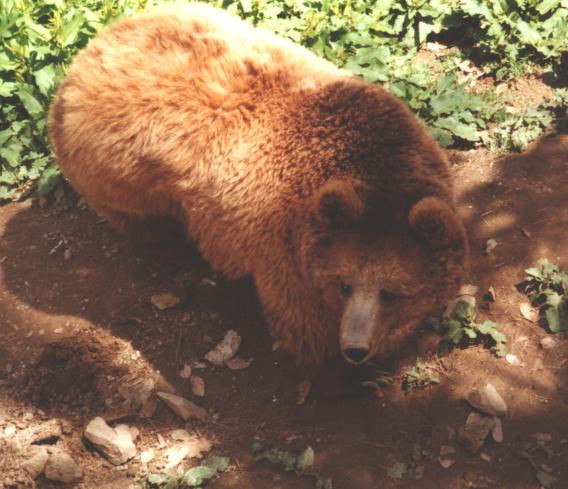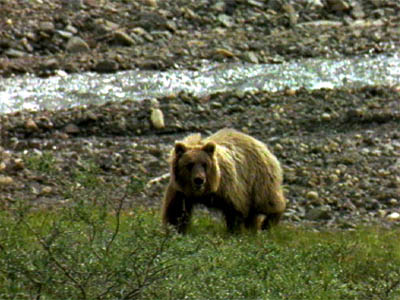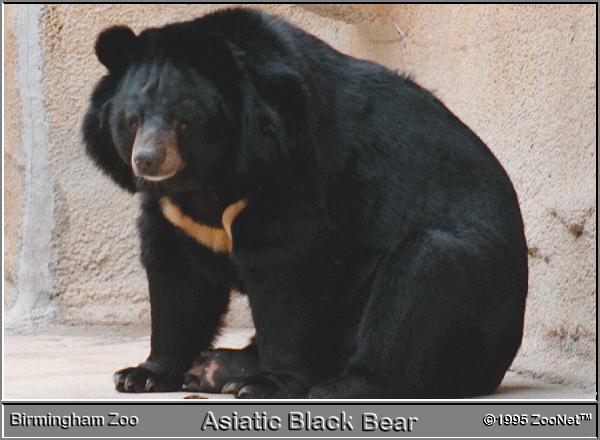 |  |
Description and Biology:
APPEARANCE: The
brown bear is a large animal, usually dark brown in color, though it can vary
from a light creamy shade through to black. The long guard hairs over the
shoulders and back are often tipped with white which, from a distance, gives a
grizzled appearance. The brown bear is characterized by a distinctive hump on
the shoulders, a slightly dished profile to the face, and long claws on the
front paws.
SIZE: There is considerable variability in the size of brown
bears from different populations, depending on the food available. Determining
representative weights of specific populations is also difficult as there are
seasonal considerations to take into account-for instance, some bears can weigh
twice as much in the fall as they might weigh in spring. Adult males may weigh
135 to 390 kilograms (300 to 860 pounds) compared with 95 to 205 kilograms (205
to 455 pounds) for females. At birth, cubs weigh 340 to 680 grams (11 ounces to
1 pound 6 ounces).
REPRODUCTION: Female brown bears reach sexual maturity at four-and-a-half
to seven years of age. Males may become sexually mature at a similar age but
are probably not large enough to be able to enter the breeding population until
they a re eight to ten years old. Mating takes place from early May to the
middle of July but implantation does not occur until about October or November.
The young are born from about January to March. The litter size ranges from one
to four, but two is most common. Cubs remain with their mothers for at least
two-and-a-half years, so the most frequently a female can breed is every three
years.
SOCIAL SYSTEM: Under most circumstances, brown bears live as lone
individuals, except for females accompanied by their cubs. During the breeding
season, a male may attend a female for up to two weeks for mating. Brown bears
are distributed in overlapping home ranges and male home ranges are larger than
those occupied by females.
DIET: Brown bears mainly eat vegetation such as grasses, sedges,
bulbs, and roots. They also eat insects such as ants, fish, and small mammals.
In some areas they have become significant predators of large hoofed mammals
such as Marco pole Sheep, Ibex and Bharal (all above information from International
Association for Bear Research and Management (IBA).
Habitat and Distribution:
Their preferred habitat includes
mountain forests, open meadows and large river. The Brown Bear in
This bear inhabits the remote northern regions of
 |  |
Discription and Biology:
APPEARANCE: This
medium-sized, black-colored bear has a lightish muzzle and ears which appear
large in proportion to the rest of its head, especially when compared with
other species of bears. There is a distinct white patch on the chest , which is
sometimes in the shape of a V, and white on the chin. A brown color phase also
occurs.
The Balochistan black bear is a sub-species of the
Asiatic or Himalayan black bear. It is smaller and possesses short, coarse,
rufous brown fur in the specimens from the south while those from the north are
much darker as compared to the Himalayan black bear. It prefers to (Olea ferruginea),
Ber (Zizyphus nummularia) as well as the starchy rhizomes and fruits of the
dwarf palm, insects and lizards.
SIZE: There is limited information available on these bears, but
total length of adults is 130 to 190 centimeters (50 to 75 inches). Adult males
range from 100 to 200 kilograms (220 to 440 pounds) and adult females from 50
to 125 kilogra ms (110 to 275 pounds).
REPRODUCTION: There is little detailed information on reproduction in
Asiatic black bears. Sexual maturity of females is thought to occur at three to
four years of age. In
SOCIAL SYSTEM: In
DIET: Asiatic black bears have been reported to feed on a wide
range of foods, including fruits, bees' nests, insects, invertebrates, small vertebrates,
and carrion. They occasionally kill domestic livestock, but the degree to which
they prey on wild hoofed mammals in unknown. In fall they frequently make crude
leafy feeding platforms in nut-bearing trees. The Baluchistan bear prefers to
(Olea ferruginea), Ber (Zizyphus nummularia) as well as the starchy rhizomes
and fruits of the dwarf palm, insects and lizards.( all above information from International
Association for Bear Research and Management (IBA) and
Habitat and Distribution: